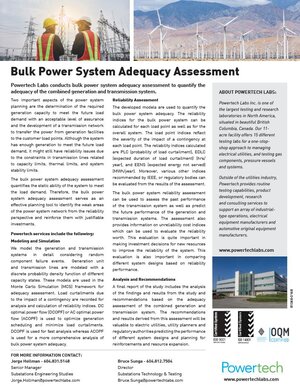Powertech Labs conducts bulk power system adequacy assessment to quantify the adequacy of the combined generation and transmission system.
Two important aspects of the power system planning are the determination of the required generation capacity to meet the future load demand with an acceptable level of assurance and the development of a transmission network to transfer the power from generation facilities to the customer load points. Although the system has enough generation to meet the future load demand, it might still have reliability issues due to the constraints in transmission lines related to capacity limits, thermal limits, and system stability limits.
The bulk power system adequacy assessment quantifies the static ability of the system to meet the load demand. Therefore, the bulk power system adequacy assessment serves as an effective planning tool to identify the weak areas of the power system network from the reliability perspective and reinforce them with justifiable investments.
Powertech services include the following:
Modeling and Simulation
We model the generation and transmission systems in detail considering random component failure events. Generation unit and transmission lines are modeled with a discrete probability density function of different capacity states. These models are used in the Monte Carlo Simulation (MCS) framework for adequacy assessment. Load curtailments due to the impact of a contingency are recorded for analysis and calculation of reliability indices. DC optimal power flow (DCOPF) or AC optimal power flow (ACOPF) is used to optimize generation scheduling and minimize load curtailments. DCOPF is used for fast analysis whereas ACOPF is used for a more comprehensive analysis of bulk power system adequacy.
Reliability Assessment
The developed models are used to quantify the bulk power system adequacy. The reliability indices for the bulk power system can be calculated for each load point as well as for the overall system. The load point indices reflect the severity of the impact of a contingency at each load point. The reliability indices calculated are PLC (probability of load curtailment), EDLC (expected duration of load curtailment) (hrs/year), and EENS (expected energy not served) (MWh/year). Moreover, various other indices recommended by IEEE, or regulatory bodies can be evaluated from the results of the assessment.
The bulk power system reliability assessment can be used to assess the past performance of the transmission system as well as predict the future performance of the generation and transmission systems. The assessment also provides information on unreliability cost indices which can be used to evaluate the reliability worth. This evaluation is quite important in making investment decisions for new resources to improve the reliability of the system. This evaluation is also important in comparing different system
Analysis and Recommendations

A final report of the study includes the analysis of the findings and results from the study and recommendations based on the adequacy assessment of the combined generation and transmission system. The recommendations and results derived from this assessment will be valuable to electric utilities, utility planners and regulatory authorities predicting the performance of different system designs and planning for reinforcements and resource expansion.
FOR MORE INFORMATION CONTACT:


